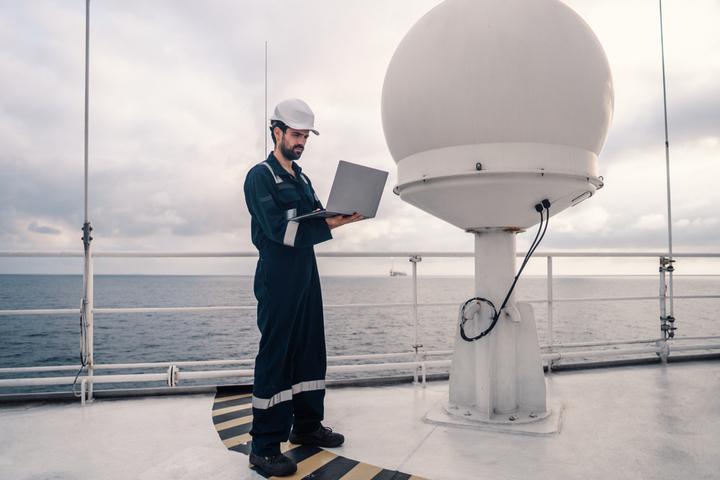Maritime Very Small Aperture Terminal (VSAT) acts as ground station for satellite to transmit and receive data from antenna smaller than 3.8 meters and can be operated on the ship or vessel in the sea. VSAT consists of an Indoor unit (IDU) used as a modem and an Outdoor unit (ODU) which receives, sends and differentiatessatellite signals.Primary objective of maritime VSAT is to ensure high speed data transmission rates throughout naval operations. Moreover, rise in demand for throughput services develops market growth of maritime VSAT devices.
COVID-19 scenario analysis:
○ VSATs have been used in remote areas to relay the data of COVID-19 spread to analyze and resolve complex situations such as community spread.
○ Demand for maritime VSAT has risen owing to the fact that real time monitoring of naval vessels and ships was essential in detection and handling of regular operations of maritime.
○ Due to restrictions and prohibitions in performance of leisure vessels, drop in revenue was faced by the leisure vessels, which adversely affected the demand for maritime VSAT.
○ On account of lockdowns implemented globally, maintenance, renewal and overhaul activities were suspended which slowed the growth of maritime VSAT market.
Top impacting factors: market scenario analysis, trends, drivers and impact analysis
Upgradation of existing communication systems, increase in demand for high-speed broadband and rise in adoption of efficient real time tracking systems are the factors that drive the global maritime VSAT market. However, cybersecurity breaches and connectivity issueassociated with the maritime VSAT system hinders the market growth. Contrarily, increase in number of low Earth orbit (LEO) constellations maritime VSATs have the opportunity to expand into remote areas.
The maritime VSAT market trends are as follows:
Upgradation of existing communication systems
Fast-paced advancement in technologies such as use of stable and resistant materials, auto-stabilized ground terminals, multi-frequency antennas and high-speed modems prompts the upgradation of existing maritime communication systems. For instance, in May 2019, under the partnership between Bharti Airtel and Hughes Communications India, combined utilization of VSAT operations was enabled in India which aimed at distribution of reliable and exceptionally secure connectivity solutions across the country.Therefore, upgradation of existing communication systems acts as a key driver for the expansion of maritime VSAT market.
Rise in adoption of efficient real time tracking systems
Rise in availability of satellite services which offer Ku-band for Very Small Aperture Terminal (VSAT) further increases the demand for larger bandwidth and broadband connection. Increasedrequirement for data analysis and processing paves way for growth in allocation of bandwidth for the maritime market. Addition of lower cost bandwidth ramps up the demand for VSAT connectivity. For instance, in January 2019, Sealink VSAT expansion contract was awarded to Marlink for international ship-owner Transpetrol. Transpetrol will utilize the increased Maximum Information Rate (MIR) and Committed Information Rate (CIR) to provide more data access for its crew. Such adoption fuels the growth prospect for the maritime VSAT market.
Key benefits of the report:
- This study presents the analytical depiction of the maritime VSAT industry along with the current trends and future estimations to determine the imminent investment pockets.
- The report presents information related to key drivers, restraints, and opportunities along with detailed analysis of the maritime VSAT market share.
- The current market is quantitatively analyzed to highlight the maritime VSAT market growth scenario.
- Porter’s five forces analysis illustrates the potency of buyers & suppliers in the market.
- The report provides a detailed maritime VSAT market analysis based on competitive intensity and how the competition will take shape in coming years.
Questions answered in the maritime VSAT market research report:
- Which are the leading market players active in the maritime VSAT market?
- What are the current trends that will influence the market in the next few years?
- What are the driving factors, restraints, and opportunities in the market?
- What are the projections for the future that would help in taking further strategic steps?
Maritime VSAT (Very Small Aperture Terminal) Market Report Highlights
| Aspects | Details |
| By Application |
|
| By Platform |
|
| By End User |
|
| By Region |
|
| Key Market Players | Viasat Inc., NSSLGlobal Technologies AS, Inmarsat PLC, KVH Industries, Telespazio SpA, OmniAccess S.L., Speedcast International Limited, EMC, Raytheon Company, VT iDirect |
Loading Table Of Content...




